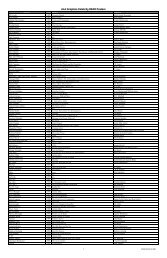sample chapters and the book's index - ALA Store - American ...
sample chapters and the book's index - ALA Store - American ...
sample chapters and the book's index - ALA Store - American ...
You also want an ePaper? Increase the reach of your titles
YUMPU automatically turns print PDFs into web optimized ePapers that Google loves.
2 Introduction: YALSA, Teens, <strong>and</strong> Reading<br />
but opinions differ on why <strong>the</strong>se challenges exist <strong>and</strong> also on <strong>the</strong> state of teens<br />
<strong>and</strong> reading in America. Are teens reading or not? Which teens are reading<br />
more, <strong>and</strong> which teens are reading less? Are <strong>the</strong>y reading what <strong>the</strong>y say <strong>the</strong>y<br />
are reading? And what counts as reading (Aronson 2006; Gardner <strong>and</strong> Dillon<br />
2005; National Endowment for <strong>the</strong> Arts 2007)? The pendulum of public opinion<br />
swings between <strong>the</strong> idea that young adults are not reading at all <strong>and</strong> what<br />
Aronson calls “h<strong>and</strong>-wringing over what a concerned parent fears <strong>the</strong>y might<br />
be reading too avidly” (Aronson 2005). So what is <strong>the</strong> reality behind <strong>the</strong>se<br />
seemingly contradictory ideas regarding teens <strong>and</strong> reading?<br />
A good place to start unraveling <strong>the</strong> mystery about teens <strong>and</strong> <strong>the</strong>ir reading<br />
habits is with a look at <strong>the</strong> origins of <strong>the</strong> concept of reluctant readers. A common,<br />
long-st<strong>and</strong>ing perception about why teens are not reading or are reluctant to<br />
read is associated with reading skill. When reading is difficult for <strong>the</strong>m, <strong>the</strong>y do<br />
not like to do it. This belief about why teens are reluctant readers is not a new<br />
concept. In 1952, <strong>the</strong> Executive Committee of Capital Area School Development<br />
Association recognized <strong>the</strong> needs of low-level teen readers <strong>and</strong> produced Fare<br />
for <strong>the</strong> Reluctant Reader—an annotated listed of teen-tested titles divided by<br />
grade level <strong>and</strong> category (Bush <strong>and</strong> Dunn 1952). The idea that teens do not read<br />
because <strong>the</strong>y lack <strong>the</strong> skills to do so has remained popular over <strong>the</strong> years <strong>and</strong><br />
has led to such ideas as connecting teens to reading through hi/lo books—books<br />
deemed to have high interest but requiring low reading skills (LiBretto 1985;<br />
Williams 1987).<br />
As <strong>the</strong> concept was developed more fully, <strong>the</strong> reasons some teens fall into<br />
this category became more complex. The thought that teens are not reading<br />
simply because <strong>the</strong>y lack <strong>the</strong> skill gave way to more nuanced discussions. By<br />
1969, <strong>the</strong> term reluctant reader had exp<strong>and</strong>ed to include readers “who have <strong>the</strong><br />
ability to read without mechanical problems but have little or no inclination<br />
to read except what is required for work or normal everyday life” (Chambers<br />
1969, 4). This view included a list of reasons that youth ages 11–17 were not<br />
reading—a list that probably sounds familiar to many of today’s librarians:<br />
<strong>the</strong> dislike of stories, <strong>the</strong> lack of time, <strong>the</strong> fact that teens like group activities,<br />
<strong>and</strong> <strong>the</strong> influx of technology replacing reading as a leisure time activity. In<br />
her 1996 School Library Journal article “No Time, No Interest, No Way: The 3<br />
Voices of Aliteracy,” Kylene Beers demonstrates <strong>the</strong> fur<strong>the</strong>r evolution of <strong>the</strong><br />
reluctant teen reader concept, with reluctant readers now classified into three<br />
categories: dormant, uncommitted, <strong>and</strong> unmotivated. The dormant reader<br />
has a positive view of reading but does not commit <strong>the</strong> time to read or lacks<br />
<strong>the</strong> free time for pleasure reading. The uncommitted reader views reading<br />
as a skill but does not have necessarily negative feelings about <strong>the</strong> skill. The<br />
unmotivated reader has a negative view of reading <strong>and</strong> readers. Stacy Creel,<br />
who worked with youth for ten years in a public library setting <strong>and</strong> spent<br />
three years on <strong>the</strong> QP committee, formulated <strong>the</strong> following categories:<br />
The A+ Student. This group of teens reads frequently for school assignments<br />
but not for pleasure. If it is not important for <strong>the</strong>ir college application,







